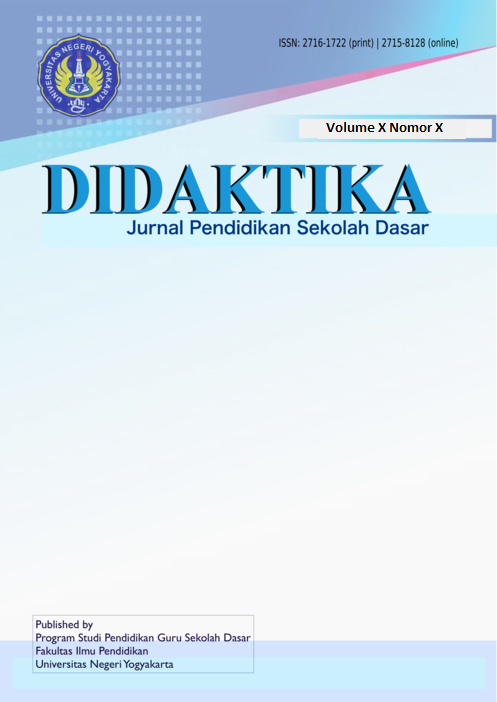Peningkatan Keaktifan Berbicara Siswa Menggunakan Model Time Token
DOI:
https://doi.org/10.21831/didaktika.v1i2.28088Abstract
This research aims to improve the talking activity in Topic 2: Playing Around in My Environment of class IIC in SD Negeri Jarakan through the use of Time Token model. The data collecting methods were observation and documentation. The data analytic techniques were quantitative descriptive and qualitative descriptive. The research's result shows that there is an improvement in class IIC's talking activity using Time Token model. It is proven by the percentage of the students who surpassed the minimum passing criteria during learning activity which was 13,04% in pre cycle increased to 19,66% in cycle 1 and increased again to 60,86% in cycle 2. The result is supported by the observation's result that recorded the teacher and students' activity in using Time Token model, which was 85,29% in cycle 1 increased to 88,23% in cycle 2. The four aspects of talking activity are stating feelings, giving suggestions, asking, transferring ideas, and discussion.
References
Shoimin, A. (2014) 68 Model Pembelajaran Inovatif dalam Kurikulum 2013. Yogyakarta: Ar-Ruzz Media.
Suprihatiningrum, J. (2016) Strategi Pembelajaran; Teori dan Aplikasi. Yogyakarta: Ar-Ruzz Media.
Huda,H. (2013) Model-model Pengajaran dan Pembelajaran; Isu-isu Metodis dan Paradigmatis. Yogyakarta: Pustaka Pelajar.
Suparno, P. (2004) Guru Demokratis di Era Reformasi. Jakarta: PT. Grasindo
Ahmad, R. (2004.) Pengelolaan Pengajaran. Jakarta: Erlangga
Downloads
Published
How to Cite
Issue
Section
Citation Check
License
- Authors retain copyright and grant the journal right of first publication with the work simultaneously licensed under a Creative Commons Attribution License that allows others to share the work with an acknowledgement of the work's authorship and initial publication in this journal.
- Authors are able to enter into separate, additional contractual arrangements for the non-exclusive distribution of the journal's published version of the work (e.g., post it to an institutional repository or publish it in a book), with an acknowledgement of its initial publication in this journal.
- Authors are permitted and encouraged to post their work online (e.g., in institutional repositories or on their website) prior to and during the submission process, as it can lead to productive exchanges, as well as earlier and greater citation of published work.






